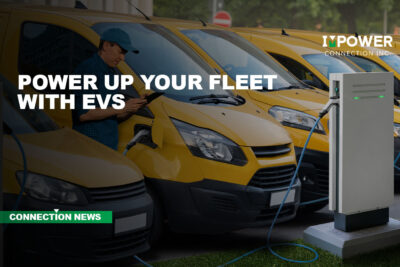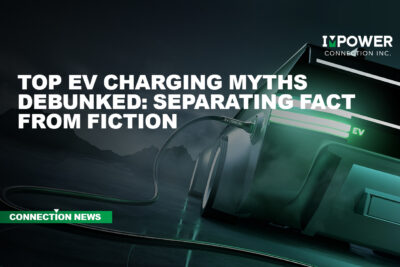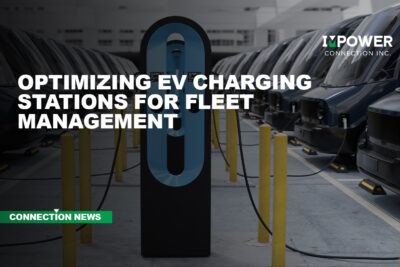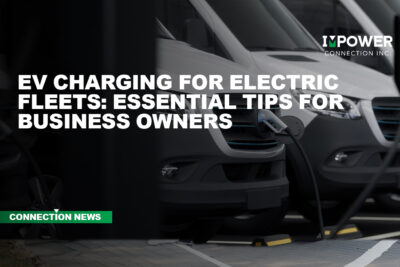How It Works
Impower Connection - How it Works
Do you want EV charging infrastructure to charge your fleet or attract customers to your business? You may want the system as an amenity for residents in your multi-family complex, or to help you attract and retain top employee talent for your company.
Some companies want EV charging stations to demonstrate their commitment to sustainability or leading-edge technology or to use the hardware as an advertising opportunity for their businesses.
One of the greatest motivators to get EV charging now is to take advantage of the billions of dollars in incentives available from the federal government.
Here are the steps you need to take to get a commercial-grade EV charging system to achieve your goals.
There are many reasons for wanting EV charging stations. Your motives and budget will determine the type of system you need.
Jot down your intentions for the EV charging system and prioritize them in order of most important to least important, so you don’t lose sight of your goals for the project.
Here are some of the most common reasons to get EV charging:
- Attract EV drivers to spend money in your business
- Add a revenue stream to your business.
- Offer an amenity to the community.
- Reduce tail pipe emissions in your community.
- Gain visibility for your business on EV charging site locator maps.
- Show the public that you care about the environment.
- Reap cost of ownership savings for your commercial fleet
- Offer an amenity to employees.
- Offer an amenity to residents in multi-family residential complexes.
- Gain a competitive advantage over your competitors.
- Take advantage of tax incentives and government grants that may apply.
EV chargers and charging infrastructure are typically used at commercial locations as a revenue stream or to offer an amenity. It has been proven that EV drivers enter site host locations and spend money while they wait for their vehicles to charge.
If you want your EV charging infrastructure to attract customers, you will want to place it in a prominent location. Yet, one that is not front and center, because depending on the speed of the charging system you have, the cars will be parked there for 10-30 minutes which could be an inconvenience for your regular customers.
If your system is intended for fleet use, you will want to place your chargers in a secure area to be sure they are reserved for your vehicles.
Things to Consider when Planning your EV Charging Infrastructure
When installing EV charging infrastructure, it is important to consider your community. The electric vehicle market will continue to expand, and the number of gasoline-powered vehicles will decline. Consider this increasing demand, technology, convenience, and safety to ensure you choose the best location on your site. This information helps to better determine the capacity and charging infrastructure needed for the project.
When determining the placement of your EV chargers, it is essential to ensure consistent, fair access. Low-income and underserved communities often face higher rates of environmental harm, and electric vehicle charging infrastructure can facilitate EV adoption to reduce ecological damage and deliver the savings EVs offer to those benefit the most from those savings.
Making your EV Charging Infrastructure Site Accessible for ADA Accommodations
It is essential to provide a friendly and inclusive charging experience for everyone, especially for disabled EV drivers. The Americans with Disabilities Act (ADA) calls for charging hardware that ensures ease of use, allowing one-handed operation without grasping, squeezing, twisting the wrist, or exerting more than five pounds of force.
ADA regulations also require enough space for a wheelchair to move freely around the charger without curbs. It is also important to create appropriate slopes to prevent wheelchairs for accidental rolling. Approximately one parking space is needed for ADA accessibility, so if you have 24 charging stations or fewer, one ADA accessibility is sufficient.
Based on your physical location, you may qualify for grants (free money) or tax incentives to help offset the costs of your system.
The incentives may overlap and completely cover the costs of your installation.
If you intend to help fund your system with grants and incentives from the National Electric Vehicle Infrastructure (NEVI) program, your stations must be available 24 hours per day, seven days per week. For example, if you intend for your stations to be fenced in at night, they will not qualify for a NEVI grant.
How Does NEVI Work?
In November 2021, the Bipartisan Infrastructure Act (BIL) was enacted, allocating $5 billion spread amongst the states to fund a network of EV chargers over the course of five years.
This plan is known as “NEVI” an acronym for the National Electric Vehicle Infrastructure, a formula program by the U.S. Department of Transportation and the Federal Highway Administration.
The intent of this plan is to help accelerate EV adoption by giving the public access to a reliable, easy-to-find EV charging network along interstate highways.
In each of the five years, the plan targets different types of locations including sites along federally funded highways, county seats, and other targeted areas.
The states are responsible for awarding the funding in their jurisdictions. In the first year, these grants may cover up to 80% of the cost of EV charging stations for recipients.
Each state has its own plan, which was approved by federal authorities. Each plan meets the federal criteria while responding to the respective needs and challenges within the state.
What Types of Grants Are Available?
Locations along major federally funded highways and alternative fuel corridors, areas that need air quality improvement or are economically challenged are key areas designated for federal grant funding.
There are various grants, rebates, and tax incentives for implementing EV charging infrastructure. These grants can be complex, in part because each state has some unique requirements for their program, some of which are still being determined. For this reason, it is best to consult with an expert on these grants to help navigate the requirements and application process.
Refer to each state’s plan for specifics.
- EV Tax Credit 2023 – Alternative Fuel Vehicle Refueling Property Credit. Beginning January 1st, 2023, fueling equipment, including electric vehicle charging stations installed through December 31st, 2032, will be eligible for an Alternative Fuel Vehicle Refueling Property Credit of 30% or up to $100,000.
- Vehicles weighing less than 14,000 pounds qualify for up to $7,500, and those that weigh even more may be eligible for up to $40,000 in commercial tax credits.
- Some state environmental authorities are providing grants to replace or upgrade older vehicles and equipment to reduce emissions and promote EV adoption.
- Some energy companies are offering commercial customers rebates when they install qualified EV charging stations in specific types of locations, such as multi-unit dwellings and workplaces.
- Regional planning organizations are offering grants, primarily with the intent to improve air quality.
The federal government created an initiative entitled Justice40 to foster environmental equity. The program intends to distribute 40 percent of the overall benefits such as electric vehicle charging stations and grants to disadvantaged communities which often face greater rates of pollution. The program enables those in the Justice40 areas to reap the savings EVs provide and creates an economic driver in these areas.
How Can I Apply for EV Charging Infrastructure Grants?
When it comes to finding and applying for EV infrastructure grants, there are many frequently asked questions…
Do I qualify?
How do I apply?
How long does the application process take?
What are all the steps in the process?
Do you have to pay back grants?
Do you get the funding before you install your system or after it is installed?
The answers to all of these questions vary depending on the grant and entity awarding it. There is however, one consistent answer to one of these questions – no, you don’t have to repay grants.
Features, appearance, cost, availability, and level of power system needed for your chargers are leading factors in the decision-making process.
If you are targeting a NEVI grant to fund your site, you must use Level 3 DC fast chargers that achieve specified kilowatts and comply with sourcing guidelines such as Buy America. We represent leading EV charging manufacturers, such as Blink, ABB, Tritium, Freewire, BreezEV, and others.
We will guide you through choosing EV charging hardware to meet your unique needs and budget.
A master electrician will need to assess the power and equipment (such as switches and transformers) you currently have at your site and the amount of energy you already use. To accomplish this, the electrician will need access to your electrical panels and other areas where the transmission system components are located.
Be sure to provide the details of the power assessment to an electrical engineer along with the technical information for the EV chargers you are considering. The engineer will review your current power system and compare it with the equipment you desire to design your system.
EV charging systems typically require an electrical engineer and sometimes a civil engineer to consult on the design. An electrical engineer will study your current electrical infrastructure and power usage. The electrical engineer will design your system with components to provide ample power and transmission gear.
Share your preferences for charging hardware and your goals for the system at the outset so they can be analyzed by the engineer to verify your preferred equipment will indeed be able to meet your goals within your budget.
Electrical engineers are critical to the success and safety of EV charging systems because they provide the design documents or plans detailing where the stations will go, how much power is needed, where the power will come from, which electrical equipment is necessary (service, switches, transformers, cabling, etc.) to deliver the power to the chargers as well as where to place all of the equipment and how to connect them.
Level 3 fast charging systems are funded through the federal government NEVI program and likely require significant infrastructure upgrades at your location. This work should be completed by a professional electrical engineer licensed in your state. A professional engineer will design your system to safely meet your goals and meet the requirements of your selected chargers.
The engineer will help you determine the pricing of the complete system and advise you on whether the location on your site is ideal. There may be another location that achieves your goals and reduces the infrastructure required for your system.
For example, if you have a transformer on one side of your building, placing your system nearer the power source is typically more cost-effective because of the reduction in trenching, concrete, conduit, wiring, and switchgear required.
The engineer(s) will provide deliverables in the form of plans and specifications (“specs”) for your project. You will provide these plans and specs to the installer of your EV charging system.
For charging stations at new-build sites, the engineer designing the electrical system for the rest of the project may design the electrical system for the EV charging infrastructure. However, you will want to have a separate service set up for your EV charging system. This is because the pricing for electricity delivered to EV chargers will most likely face regulations in the future. It is best to keep these systems separate from the start so you can avoid having to add a new service later when the rules take effect.
How to Choose an Electrical Engineer
Always choose an electrical engineer that is licensed in your state. Ideally, your electrical engineer will have experience designing electrical infrastructure for EV charging stations.
Conduct due diligence by reviewing the engineer’s qualifications (resume and project experience). Ask for references and follow through by contacting the references. Research the firm as well as the individual engineers that will be working on your project. Check to verify if there are complaints registered with the licensing bureau. Interview the engineer to determine if they communicate well and better determine if you have a rapport and trust them.
Does the engineer listen, ask questions, and acknowledge your needs and concerns? Will the engineer be respectful of your budget, goals, and time frame?
Ask for a proposal that includes a detailed scope of work, complete with costs. Be sure to read the terms and conditions. Consult your legal and financial professionals before agreeing to contracts and pricing. It is helpful to go through this process with a couple of firms so you can compare pricing and services.
Why Might I Need a Civil Engineer for My EV Charging System?
A civil engineer may be required for your project at the site where buildings are already located to verify proper drainage to your chargers and structures. In addition, if disabled parking is required for the site, slope and elevation are critical to providing safe egress to those in wheelchairs or with other apparatus. Civil engineers design grading plans so your site has the proper slope.
Electric companies provide electricity to businesses, and as such, utilities play an important role in delivering the needed power for EV charging infrastructure. The EV installation process needs to be synchronized with the local utility company, and electrical upgrades may be required by authorities to achieve compliance with current building codes.
Coordinating with the power company early during the planning and construction process will save money and time during the construction process. It could take months for the power company to deliver the power needed to your site, including running new power lines or installing new power poles.
Contacting them as early as possible will help the process begin so your chargers can get up and running with fewer opportunities for delays.
The power company will assess grid-level constraints depending on the scale of the project. They will want to know the details of your system, so have the plans and specs prepared by your engineer handy to send them.
Coordinating with these companies will happen at multiple stages throughout the process to determine electrical needs and limitations, which will help determine pricing structure and electricity rates.
Determining which type of utility serves your location will help identify opportunities for potential partnerships. Investor-owned utilities serve most customers nationwide. Meanwhile publicly owned utilities are run by state, federal, or municipal entities. Cooperatives, known as “co-ops,” are not-for-profit.
ABB, Blink, Tritium, BreezEV, and JuiceBar are leading manufacturers. When choosing a manufacturer consider the factors that are most important to you. Each manufacturer has unique features and benefits.
- ABB is a technology leader that prioritizes innovative, reliable solutions like vehicle-to-grid chargers (V2G).
- Blink is a global company that prioritizes the diversity of its products.
- Tritium prioritizes the lifespan of its product and its environmental effects.
- BreezEV specializes in level 2 chargers.
- JuiceBar prides itself on being manufactured in the United States, which they say reduces supply chain issues.
Software cloud platforms are third-party services that monitor and update chargers 24/7. They serve as a point-of-sale system, optimizing the hardware, and monitoring the charger for downtime. Downtime is the term for when a charger is not functioning properly and thus is unusable. The cloud platform uses a cellular signal to notify the owner and maintenance service of a system outage enabling a repair.
Choosing a cloud platform with a good reputation and a reliable network is crucial, because they help your consumers feel your system is dependable. The growing demand for EVs is dependent upon a cloud system with the capacity to scale and manage extensive charging networks quickly and reliably.
This also includes managing large volumes of online transactions and analyzing data. In this regard, cloud-based solutions equipped with insight and reporting capabilities have the potential to meet these requirements. Built-in cybersecurity is a critical priority when choosing a cloud platform because a cyber-attack could jeopardize your revenue and reputation amongst customers.
Like choosing an engineer, do your due diligence to find an installer. Electricians typically install EV chargers. Be sure to choose an electrician licensed in your state with experience and knowledge of EV charging hardware.
There are several aspects of installing EV charging infrastructure such as cutting concrete, boring under concrete, running conduit and wires, installing new switch gear and transformers, installing surveillance equipment, lighting, canopies and signage, replacing landscape and painting the parking spaces.
While an electrician can certainly handle the electrical work, it is simpler to find a turn key solutions provider that can handle all of these tasks. Not only does it make for a simpler project, it make for a smoother ownership experience because if there is an issue, you only need to make one contact.
Conduct due diligence by reviewing the installer’s qualifications (resume and project experience). Ask for references and follow through by contacting the references. Research the company as well as the electrician will be working on your project. Check to verify if there are complaints registered with the licensing bureau or gross safety violations.
Ask the installation company about delivery times for you chargers, how long will the installation process take? What are their safety protocols and track record?
Ask for a proposal that includes a detailed scope of work, complete with costs. Be sure to read the terms and conditions. Consult your legal and financial professionals before agreeing to contracts and pricing. It is helpful to go through this process with a couple of installers so you can compare pricing and services.
When adding new electrical infrastructure, you will likely need a permit from your local governing entity, such as a city or county building official. This can be obtained by contacting the city authority and inquiring about what level of work necessitates a permit and paying a fee. Permitting fees vary by jurisdiction but are typically a percentage of the project cost.
Be sure to have your engineering plans and specs handy to share with the officials. They will want to review these documents to be sure the plans adhere to the International Electric Code as well as local building codes and regulations.
To obtain the project’s approval once it is complete, the governing entity will need to inspect the system to ensure it was completed to the plans and specifications they previously approved.
Installing EV charging stations can be a complex process because of the involvement of trade contractors, electricians, building officials, and utility companies.
The installer will use the engineering plans to procure the proper equipment for your system. Using the plans, the installer will need to place the new electrical power equipment such as switch gear and transformers in the designated location to service the new EV infrastructure.
The installer will need to create a trench and (haul away the removed substrate such as dirt or concrete debris) to run conduit down into the ground from the switch gear and horizontally toward the chargers. The conduit will then run up vertically creating a “stub-up” to the location where the chargers will be placed. You should use larger conduit if you plan to expand your system in the future.
Chargers will then be installed over the stub-up and secured in place. Bollards should be placed around your electrical equipment and chargers to protect them from vehicles.
The trench will need to be replaced with new concrete. Related site improvements such as lighting, security cameras, canopies, landscaping, signage and parking lot painting should all be completed as finishing touches for the project.
Certified commissioning is the final steps a certified installer will complete to get your charger operational and connected to a point-of-sale platform so you can collect payments and change your prices at your discretion.
EV commissioning is done by a conducted by certified professionals connecting to the cloud, giving full safety functionality. Once the commissioning is finished, the site operator will receive instructions on how to use the system and the site will be fully functional.
Long-term maintenance is critical to the success of your EV charging business and protecting your investment.
Typical maintenance items include ensuring software updates regularly, changing filters, sensors, and making sure the connectors and hoses are in tact and functioning properly. Refer to your owner’s manual to learn more about your chargers and how to maintain them.
Research EV charger maintenance plans to help make your EV ownership experience worry free. These plans may include proactive visits and visits in response to notifications of chargers that are down.
Customer Satisfaction




Most Recent Articles
Power Up Your Fleet with EVs and get on the Road to Saving Time and Money with Impower Connection
Top EV Charging Myths Debunked: Separating Fact from Fiction
Optimizing EV Charging Stations for Fleet Management
The Importance of Data Analytics in EV Charging Infrastructure
EV Charging for Electric Fleets: Essential Tips for Business Owners
Preparing for the Future: Wireless EV Charging Technology

TECL #37244








